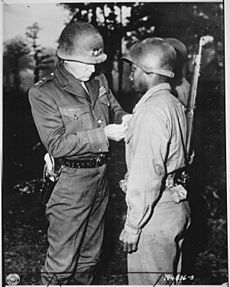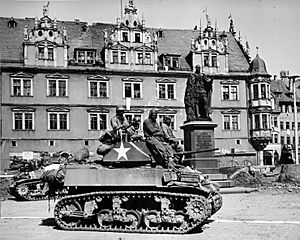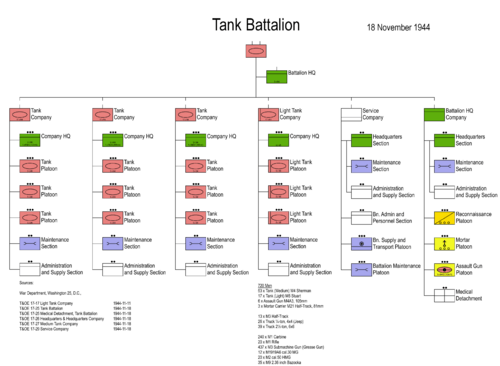761st Tank Battalion (United States) facts for kids
Quick facts for kids 761st Tank Battalion |
|
|---|---|
 |
|
| Active | 1942–1946 (segregated unit) 1947–1955 (integrated unit) |
| Allegiance | United States |
| Branch | United States Army |
| Type | Separate tank battalion |
| Role | Armored warfare |
| Size | Battalion |
| Nickname(s) | Black Panthers |
| Motto(s) | Come Out Fighting |
| Colors | Blue, red, yellow |
| Mascot(s) | Black panther |
| Engagements | World War II
|
| Decorations | |
| Commanders | |
| Notable commanders |
Lt. Col. Paul L. Bates |
The 761st Tank Battalion was a separate tank battalion of the United States Army during World War II. The 761st was made up primarily of African-American soldiers, who by War Department policy were not permitted to serve alongside white troops; the U.S. military did not officially desegregate until after World War II. The 761st were known as the Black Panthers after their unit's distinctive insignia, which featured a black panther’s head; their motto was "Come out fighting". The battalion received a Presidential Unit Citation for its actions. In addition, a large number of individual members also received medals, including one Medal of Honor, 11 Silver Stars and about 300 Purple Hearts. The unit has been called "one of the most effective tank battalions in World War II".
Contents
Prior to combat
Immediately before and during World War II, U.S. military leaders had reservations about using African American soldiers in combat. General Lesley J. McNair, the commander of Army Ground Forces, successfully argued that "colored" units should be employed in combat. At McNair's suggestion, the U.S. Army began to experiment with segregated combat units in 1941; the program was supported by, and given national exposure in, Life magazine. The 761st was constituted on 15 March 1942, and activated 1 April 1942, at Camp Claiborne, Louisiana. The battalion began training in M5 Stuart light tanks.
Most of the black tankers had to train in installations located in deep Southern states such as Kentucky, Louisiana, and Texas. In the days before the civil rights advances made in the 1960s, black people were still treated harshly in the South and often considered an inferior race there. The men of the 761st trained for almost two years, conscious of the fact that white units were being sent overseas after much less training.
Jackie Robinson and segregation
The most famous member of the 761st was First Lieutenant Jack Roosevelt “Jackie” Robinson. During the 761st's training, a white bus driver told Robinson to move to the back of the bus. Robinson refused and was arrested. Battalion commander Lieutenant Colonel Paul L. Bates refused to consider the court-martial charges put forward by the arresting military policemen. The post commander transferred Robinson to the 758th Tank Battalion, whose commander was willing to sign the insubordination court-martial order. Robinson was acquitted of all charges. After the war, he was instrumental in desegregating professional baseball.
Deployment
General Ben Lear, commander of the U.S. Second Army, rated the unit "superior" after a special review and deemed the unit "combat ready." After a brief deployment to England, the 761st landed in France via Omaha Beach on 10 October 1944. The unit arrived (with six white officers, thirty black officers, and 676 black enlisted men) and was assigned to General George Patton's US Third Army at his request, attached to the 26th Infantry Division.
The unit saw action in Northern France from October 1944, it fought in the Battle of the Bulge, later proceeding to the Rhineland, and spent the final months of the war on German soil.
Combat record


The battalion first saw combat on 7 November 1944, fighting through towns such as Moyenvic, Vic-sur-Seille, often at the leading edge of the advance. The fighting that 761st engaged in at Morville-lès-Vic was particularly brutal. The unit endured 183 days of continuous operational employment.
The 761st Tank Battalion suffered 156 casualties in November 1944. The unit also lost 14 tanks evacuated and another 20 damaged in combat. In December, the battalion was rushed to the aid of the 101st Airborne Division at Bastogne. As part of the effort to drive the Germans from the vicinity of Bastogne, the battalion fought to capture the city of Tillet, less than 15 km west of the town in early January 1945. Supporting the elements of the 87th Infantry Division with just 11 tanks, the battalion took control of the city from the 113th Panzer Brigade through 2 days of combat, losing 9 tanks in the process.
After the Battle of the Bulge, the unit opened the way for the U.S. 4th Armored Division into Germany during an action that breached the Siegfried Line. The 761st smashed through dozens German cities and towns in their rapid advance through the Reich. In the final days of the war in Europe, the 761st was one of the first American units to reach Steyr, Austria, at the Enns River, where they met with the 1st Ukrainian Front of the Soviet Red Army. On May 4, 1945, the 761st, along with the 71st Infantry Division, liberated the Gunskirchen concentration camp; the German guards had fled not long before.
The 761st was deactivated 1 June 1946 in Germany. They have been called "one of the most effective tank battalions in World War II." In all, the battalion earned about 300 Purple Hearts.
Ruben Rivers' Medal of Honor
For unusual heroism in serving with Company A of the 761st, the Medal of Honor was awarded posthumously to Staff Sergeant Ruben Rivers in 1997.
Official Citation:
For extraordinary heroism in action during the 15–19 November 1944, toward Guebling, France. Though severely wounded in the leg, Sergeant Rivers refused medical treatment and evacuation, took command of another tank, and advanced with his company in Guebling the next day. Repeatedly refusing evacuation, Sergeant Rivers continued to direct his tank's fire at enemy positions through the morning of 19 November 1944. At dawn, Company A's tanks began to advance towards Bougaktroff [sic, correct name is Bourgaltroff], but were stopped by enemy fire. Sergeant Rivers, joined by another tank, opened fire on the enemy tanks, covering company A as they withdrew. While doing so, Sergeant River's tank was hit, killing him and wounding the crew. Staff Sergeant Rivers' fighting spirit and daring leadership were an inspiration to his unit and exemplify the highest traditions of military service.
"Baddest Man in the 761st"
Tank commander Sergeant Warren G. H. Crecy came to the aid of his men on 10 November 1944, and fought through enemy positions until his tank was destroyed; he eliminated the enemy position that had knocked out his tank by commandeering a vehicle armed with only a .30-caliber machine gun. He then killed the German forward observers who were directing artillery fire on the US positions.
After manning a replacement tank, Crecy's new vehicle lost traction in heavy mud and he was forced to exit the tank under fierce machine gun, antitank, and artillery fire to free it. When attacked by German infantry, he had to abandon his salvage efforts to man the tank's .50-caliber machine gun, stopping the advancing enemy and forcing them to withdraw.
Described as a baby-faced, "quiet, easy-going, meek-looking fellow", Crecy had destroyed an antitank position and a number of German machine gun positions armed only with a machine gun and without regard for his personal safety, under heavy fire. His men reportedly experienced difficulty getting the machine gun away from him after the action.
Crecy was nominated for the Medal of Honor and received a battlefield commission, eventually retiring with the rank of major. His heroic actions earned him the title "Baddest Man in the 761st" from his comrades.
After World War II
Returning soldiers of African-American units (the 761st had been the first of many segregated combat units, including the 92nd Infantry Division and the famous Tuskegee Airmen) often did not receive a warm welcome home as most white units did. Their unequal treatment was a source of much disappointment and discouragement. However, the distinguished service of many black combat units helped convince the government, now under President Harry S. Truman, to finally desegregate the US Armed Forces soon after the war ended.
On 24 November 1947, the 761st was reactivated (as an integrated unit) at Fort Knox, Kentucky, and assigned to the Regular Army, where it served until again inactivated on 15 March 1955.
Permanent monument
A monument dedicated to the 761st Tank Battalion was unveiled at Fort Hood, Texas, during a ceremony attended by surviving veterans on 10 November 2005, as a permanent tribute to soldiers who had served and continued to serve throughout the world for liberty, honor, and democracy. The monument features four black granite tablets surrounding a life-size marble sculpture of a 761st Tank Battalion fighter kneeling atop a black granite pedestal engraved with a tank on the front and a panther on the back.
The monument is located on 761st Tank Battalion Drive.
Awards
- CAMPAIGN STREAMERS: Northern France, Rhineland, Ardennes-Alsace, Central Europe.
- Presidential Unit Citation
- Medal of Honor: 1
- Purple Hearts: 296 (8 with clusters)
- Silver Stars: 11
- Bronze Stars: 69
Countries: France, Belgium, the Netherlands, Luxembourg, Germany, and Austria.
Attachments
| (1 April 1942 – 1 June 1946) | |
|---|---|
| Lt Col Edward E. Cruise | 1 April 1942 – 21 November 1942 |
| Maj John R. Wright Jr. | 22 November 1942 – 3 July 1943 |
| Lt Col Paul L. Bates | 4 July 1943 – 8 November 1944 |
| Lt Col Hollis E. Hunt | 9 November 1944 – 23 February 1945 |
| Lt Col Paul L. Bates | 24 February 1945 – 1 June 1946 |


